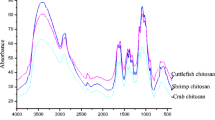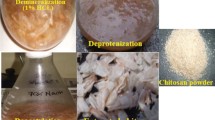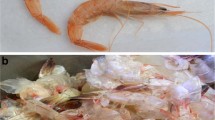Abstract
New chitosan powder extracted from eggs capsules of Rapana venosa and commercial chitosan powder were analyzed by spectral (UV–Vis) and color methods. The novelty of this study consists in the first time toxicity evaluation of the chitosan extracted from the walls of Rapana venosa eggs capsules. The evaluation was focused on the cytological behaviour of the new-chitosan particles in two different salinity conditions (3 and 35‰), at different concentrations, on bio tester organisms. The aim of this study was to determine the biological effect of the chitosan easily extracted from new marine sources and with a low financial effort. The experimental studies were performed by exposure of Artemia salina larvae, naupliar stage in saline chitosan solutions. The larvae were picked-up in 24 h time, after hatching and they were placed in the experimental recipients of 1 mL volume capacities, three repetitions were made for each test. The bioassay effects were recorded at 24 and 48 h after experiment started. The toxicity was indicated by the registration of larvae mortality, probably, induced by the cell growth inhibitions. The obtained results showed that the high toxicity effects could be observed at low concentrations of chitosan, in law salinity solutions. Due to this cytotoxicity variability, chitosan solutions could be useful in a wide range of applications (antifouling, biomedical or sewage cleaning).




Similar content being viewed by others
References
Abu Shaala NM, Zulkifli SZ, Ismail A, Azmai MNA, Mohamat-Yusuff F (2015) Lethal concentration 50 (LC50) and effects of Diuron on morphology of brine shrimp Artemia salina (Branchiopoda: Anostraca) Nauplii. Proc Environ Sci 30:279–284
Apetroaei MR, Manea AM, Tihan GT, Zgârian RG, Schroder V, Lilios G, Apetroaei MG, Rău I (2015) Chitosan an eco-friendly biomaterial from marine invertebrates. IEEE E Health Bioeng EHB Conf 2015:1–4. https://doi.org/10.1109/EHB.2015.7391607
Apetroaei MR, Zgârian RG, Manea AM, Rau I, Tihan GT, Schroder V (2016) New source of chitosan from Black Sea marine organisms identification. Mol Cryst Liq Cryst 628:102–109. https://doi.org/10.1080/15421406.2015.1137681
Apetroaei M, Manea AM, Tihan G, Zgârian R, Schroder V, Rău I (2017) Improved method of chitosan extraction from different crustacean species of Romanian Black Sea coast. U.P.B. Sci Bull Ser B Chem Mater Sci 79(1):25–36
Artoxkit M (2014) Artemia toxicity screening test for estuarine and marine waters. Standard Operational Procedure. Microbiotests, Mariakerke-Gent, Belgium., http://www.microbiotests.be
Castritsi-Catharios J, Syriou V, Miliou H, Zouganelis GD (2013) Toxicity effects of bisphenol A to the nauplii of the brine shrimp Artemia franciscana. J Biol Res (Greece) 19:38–45
Cheba BA (2011) Chitin and chitosan: marine biopolymers with unique properties and versatile applications. Glob J Biotechnol Biochem 6(3):149–153
DIN 6174, CIE LAB 76 (2007) Colorimetric evaluation of colour coordinates and colour differences according to the approximately uniform cielab colour space, p 10
Duan D, Liu G, Yao P, Wang H (2016) The effects of organic compounds on inactivation efficacy of Artemia salina by neutral electrolyzed water. Ocean Eng 125:31–37
Dvořák P, Žďársk M, Beňová K (2009) Possibilities of alternative generation II biotests at Artemia. Interdisc Toxicol 2(2):45–47
Fatouros DG, Power K, Kadir O, Dekany I, Yannopoulos SN, Bouropoulos N, Bakandritsos A, Antonijevic MD, Zouganelis GD, Roldo M (2011) Stabilisation of SWNTs by alkyl-sulfate chitosan derivatives of different molecular weight: towards the preparation of hybrids with anticoagulant properties. Nanoscale 3:1218–1224
Finney DJ, Stevens WL (1948) A table for the calculation of working Probits and weights in Probit analysis. Biometrika 35(1–2):191–201
Forster GD, Tullis RE (1985) Quantitative structure toxicity relationship with osmotically stressed Artemia nauplii. Environ Pollut Ser A Ecol Biol 38:276–281
Freeman JA (2005) Cell differentiation is a primary growth process in developing limbs of Artemia. Biol Bull 208:189–199
Freire PL, Albuquerque AJ, Farias IA, da Silva TG, Aguiar JS, Galembeck A, Flores MA, Sampaio FC, Stamford TC, Rosenblatt A (2016) Antimicrobial and cytotoxicity evaluation of colloidal chitosan–silvernanoparticles–fluoride nanocomposites. Int J Biol Macromol 93:896–903
Gortari MC, Hours RA (2013) Biotechnological processes for chitin recovery out of crustacean waste: a mini-review. Electron J Biotechnol 16:1–14. https://doi.org/10.2225/vol16-issue3-fulltext-10
Grenha A, Al-Qadi S, Seijo B, Remuñán-López C (2010) The potential of chitosan for pulmonary drug delivery. J Drug Deliv Sci Technol 20:33–43
Hu Y-L, Qi W, Han F, Shao J-Z, Gao J-Q (2011) Toxicity evaluation of biodegradable chitosan nanoparticles using a zebrafish embryomodel. Int J Nanomed 6:3351–3359
Kandra P, Chall MM, Jyothi HK (2012) Efficient use of shrimp waste: present and future trends. Appl Microbiol Biotechnol 93:17–29
Kean T, Thanou M (2010) Biodegradation, biodistribution and toxicity of chitosan. Adv Drug Deliv Rev 62:3–11. https://doi.org/10.1016/j.addr.2009.09.004
Khosravi-Katuli K, Prato E, Lofrano G, Guida M, Vale G, Libralato G (2017) Effects of nanoparticles in species of aquaculture interest. Environ Sci Pollut Res Int 24(21):17326–17346
Kurita K (2006) Chitin and chitosan: functional biopolymers from marine crustaceans. Mar Biotechnol 8:203–226. https://doi.org/10.1007/s10126-005-0097-5
Lavtizar V, Kimura D, Asaoka S, Okamura H (2018) The influence of seawater properties on toxicity of copper pyrithione and its degradation product to brine shrimp Artemia salina. Ecotoxicol Environ Saf 147:132–138
Leng KM, Vijayarathna S, Jothy SL, Sasidharan S, Kanwarb JR (2018) In vitro and in vivo toxicity assessment of alginate/eudragit S 100-enclosed chitosan–calcium phosphate-loaded iron saturated bovine lactoferrin nanocapsules (Fe-bLf NCs). Biomed Pharmacother 97:26–37
Li Q, Dunne ET, Grandmaison EW, Goosen MFA (1992) Applications and properties of chitosan. J Bioact Compat Polym 7(4):370–390
Libralato G, Prato E, Migliore L, Cicero AM, Manfra L (2016) A review of toxicity testing protocols and endpoints with Artemia spp. Ecol Ind 69:35–49
Manfra L, Savorelli F, Di Lorenzo B, Libralato G, Comin S, Conti D, Floris B, Francese M, Gallo ML, Gartner I, Guida M, Leoni T, Marino G, Martelli F, Palazzi D, Prato E, Righini P, Rossi E, Volpi Ghirardini A, Migliore L (2015) Intercalibration of ecotoxicity testing protocols with Artemia franciscana. Ecol Ind 57:41–47
Mendes IC, Costa FB, de Lima GM, Ardisson JD, Garcia-Santos I, Castineiras A, Beraldo H (2009) Tin(IV) complexes with 2-pyridineformamide-derived thiosemicarbazones: antimicrobial and potential antineoplasic activities-. Polyhedron 28:1179–1185
Methacanon P, Prasitsilp M, Pothsree T, Pattaraarchachai J (2003) Heterogeneous N-deacetylation of squid chitin in alkaline solution. Carbohydr Polym 52:119–123
Miller CL, Tainter ML (1944) Estimation of LD50 and its error by means of log-probit graph paper. Proc Soc Exp Biol Med 57:261–264
Moura CM, Moura JMD, Soares NM, Pinto LADA (2011) Evaluation of molar weight and deacetylation degree of chitosan during chitin deacetylation reaction: used to produce biofilm. Chem Eng Process 50:351–355. https://doi.org/10.1016/j.cep.2011.03.003
Murugesan B, Sonamuthu J, Pandiyan N, Pandi B, Samayanan S, Mahalingam S (2018) Photoluminescent reduced graphene oxide quantum dots from latex of Calotropis gigantea for metal sensing, radical scavenging, cytotoxicity, and bioimaging in Artemia salina: a greener route. J Photochem Photobiol B 178:371–379
Nunes BS, Carvalho FD, Guilhermino LM, Van Stappenet G (2006) Use of the genus Artemia in ecotoxicity testing. Environ Pollut 144:453–462. https://doi.org/10.1016/j.envpol.2005.12.037
Pelka M, Danzl C, Distler W, Petschelt A (2000) A new screening test for toxicity testing of dental materials. J Dent 28(5):341–345 (ISSN 0300-5712)
Persoone G, Van de Vel A, Van Steertegem M, De Nayer B (1989) Predictive value of laboratory tests with aquatic invertebrates: influences of experimental conditions. Aquat Toxicol 14:149–166. https://doi.org/10.1016/0166-445X(89)90025-8
Persoone G, Blaise C, Snell T, Janssen C, van Steertegem M (1993) Cyst-based toxicity test: II-report on an international intercalibration exercise with three cost-effective Toxkits. Angew Zool 1:17–34
Rabea EI, Badawy MET, Stevens CV, Smagghe G, Steurbaut W (2003) Chitosan as antimicrobial agent: applications and mode of action. Biomacromol 4:1457–1465. https://doi.org/10.1021/bm034130m
Rajabi S, Ramazani A, Hamidi M, Naji T (2015) Artemia salina as a model organism in toxicity assessment of nanoparticles. J Pharm Sci 23(1):20
Rozman KK, Doull J, Hayes Jr WJ (2010) Dose and time determining, and other factors influencing, toxicity. In: Krieger R (ed) Hayes' handbook of pesticide toxicology, 3rd edn. Academic Press, New York, pp 1–94. https://doi.org/10.1016/B978-0-12-374367-1.00138-5
Shakir M, Khan MS, Alam MF, Younus H, Alam M, Lee Dong-Ung (2017) Spectral, molecular, in vivo cytotoxicity and immobilization of b-galactosidase on poly(o-toluidine)-titanium dioxide nanocomposite. J Mol Struct 1137:216–232
Shighemasa I, Minami S (1995) Applications of chitin and chitosan for biomaterials. Biotechnol Genet Eng Rev 13:383–419. https://doi.org/10.1080/02648725.1996.10647935
Solis P, Wright C, Anderson MM, Gupta M, Phillipson JD (1993) A microwell cytotoxicity assay using Artemia Salina (Brine Shrimp). Planta Med 59:250–252. https://doi.org/10.1055/s-2006-959661
Sorgeloos P, Van Der Wielen CR, Persoone G (1978) The use of Artemia nauplii for toxicity tests—a critical analysis. Ecotoxicol Environ Saf 2(3–4):249–255
Svirshchevskaya EV, Zubareva AA, Boyko AA, Shustova OA, Grechikhina MV, Shagdarova BT, Varlamov VP (2016) Analysis of toxicity and biocompatibility of chitosan derivatives with different physico-chemical properties. Appl Biochem Microbiol 52:483–490. https://doi.org/10.1134/S000368381605015X
Toǧulga M (1998) The short-term toxicity of two toxicants to Artemia nauplii. Turk J Zool 22:259–266
Verlee A, Mincke S, Stevens CV (2017) Recent developments in antibacterial and antifungal chitosan and its derivatives—review. Carbohydr Polym 164:268–283. https://doi.org/10.1016/j.carbpol.2017.02.001
Wiegand C, Winter D, Hipler UC (2010) Molecular-weight-dependent toxic effects of chitosans on the human keratinocyte cell line HaCaT. Skin Pharmacol Physiol 23(3):164–170
Yaghobi N, Hormozi F (2010) Multistage deacetylation of chitin: kinetic study. Carbohydr Polym 81:892–896. https://doi.org/10.1016/j.carbpol.2010.03.063
Younes I, Rinaudo M (2015) Chitin and chitosan preparation from marine sources. structure, properties and applications. Mar Drugs 13(3):1133–1174. https://doi.org/10.3390/md13031133
Acknowledgements
The work of Manuela Rossemary Apetroaei has been funded by the Sectoral Operational Programme Human Resources Development 2007–2013 of the Ministry of European Funds through the Financial Agreement POSDRU 187/1.5/S/155536.
Author information
Authors and Affiliations
Corresponding author
Rights and permissions
About this article
Cite this article
Apetroaei, M.R., Pădureţu, C., Rău, I. et al. New-chitosan characterization and its bioassay in different salinity solutions using Artemia salina as bio tester. Chem. Pap. 72, 1853–1860 (2018). https://doi.org/10.1007/s11696-018-0440-8
Received:
Accepted:
Published:
Issue Date:
DOI: https://doi.org/10.1007/s11696-018-0440-8




